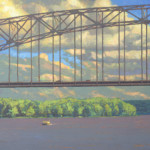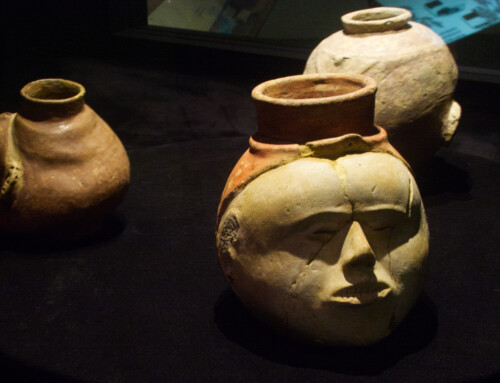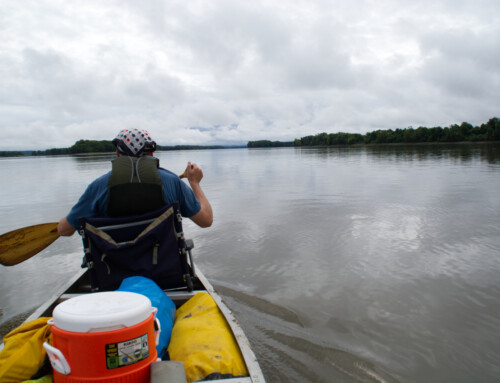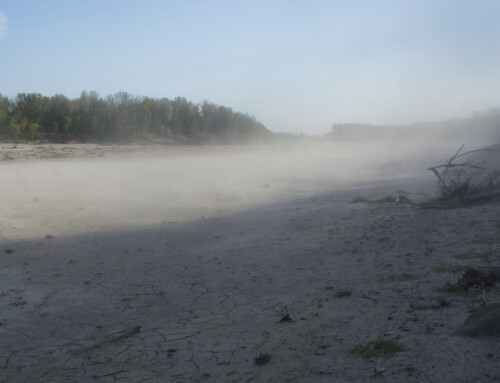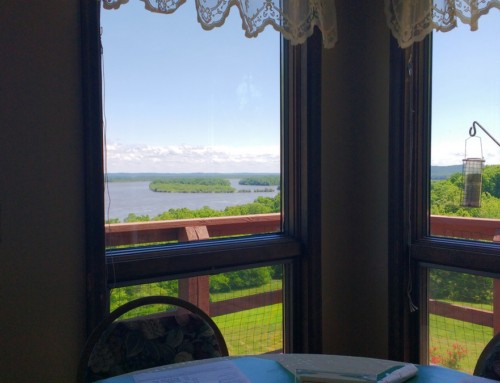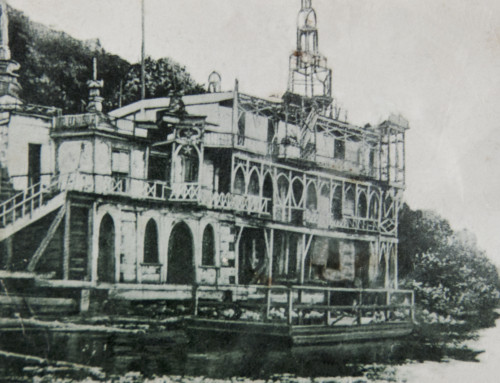Like many of us, painter Thomas Paquette had a simple idea that quickly grew out of control. His plan to paint the 72-mile stretch of the Mississippi River through the Twin Cities morphed into “Why not paint the whole river?” It took a while to explore the river and complete the paintings, but the results are worth the wait.
Several of the paintings from this big project will be exhibited around the upper Midwest in coming months, with the opening set for this week at Minnesota Marine Art Museum in Winona, Minnesota. You can catch the opening reception on Thursday, April 19 from 5-7. The exhibit opens to the public on Friday, April 20, and Paquette will be at the museum on Saturday, April 21 at noon to talk about his work.
I interviewed Paquette about the project and exhibition by email.
DK: Tell me how you came to the idea to paint the Mississippi River.
TP: The idea kind of slipped out of my mouth before I had a chance to really consider what I was proposing. I was speaking with a curator about some works I was working on from the Mississippi National River and Recreation Area, a 72-mile stretch of the river around the Twin Cities. Before I knew it I was talking about painting the other 2250 miles as well, which seemed at the time like an enormous undertaking. Which of course it turned out to be.
DK: You have lived in several different places along the Mississippi River. What were your strongest memories of the river before you started this project?
TP: I have a great number of memories from the river and I am not sure which would be the strongest. Sitting on its silty shore on an island in Minneapolis is certainly an early impression. Later ones seem to have far more impact, such as calculating its great strength and depth (and my chances of surviving a bridge collapse) as I used to drive on the scary old bridge that used to cross the river at Alton. Today I am still riveted by the knowledge I was given as a boy, that the hills even miles inland from its shores were the old shoreline of a far more powerful Mississippi. This earth, and that river, continue to produce in me a tangible sense of time more powerful than looking out at the stars on a clear night.
DK: Once you were on the road, you faced so many choices about when and where you could paint. How did you choose a scene to paint?
TP: Driving up and down its shores from beginning to end, I tried to be as close to the Mississippi as possible. When I sense a painting subject is lurking nearby (that’s about how it feels), I snoop around as much as I can until I find it. I sought environments and scenes that were endemic to the river, but not necessarily ones I would normally have chosen to paint, and followed wherever that would lead. I only hoped that the project wouldn’t end in dozens of paintings of treed shorelines with not much to differentiate them. I wanted to open my eyes to what presented itself in my meanderings up and down its shores, no matter the subject, as worthy of spending a month painting. Sometimes it was a shoreline path, the water itself, a city that grew on its banks, or a nuclear power station perched nearby. I think this helps explain why any one painting might have a very different feel from many others: any one place on the river has a very different feel from most others.
DK: Describe how you worked once you picked a scene to paint.
TP: When I do sense there is painting lurking in my midst, I might make a sketch, take notes and a number of photos to help ferret it out. Sometimes I just gaze for a while. I am a terrible photographer and so I need to take several photos to help remind me of that particular place and what I hoped to re-live in paint on canvas. I rarely paint in oils on site because it arbitrarily cuts short the time I typically need to invest in a painting. After all, the light is fleeting, the day is short, the river is long – and an average painting requires a month of my coming back to it day after day. Sometimes a miracle occurs and it is done in two weeks but it’s more often months or years of tweaking than a weeklong affair. This is not the temperament of a plein air painter, as you would correctly surmise.
DK: You spent a lot of time on the road to complete these paintings. What were some of your favorite/most memorable experiences as a traveler along the river?
TP: I love a commanding view. In the bluff country between Red Wing and Dubuque especially, it was impressive that some communities went out of their way to accommodate the vistas, like Pike’s Peak and Mississippi Palisades state parks as well as others that I painted. In other landscapes, common along the Lower Mississippi, the levees containing – or attempting to contain – the river were often jaw-dropping reminders of the strength of these waters. As I came into a small river town, and climbed the man-made banks higher than houses to get a glimpse of the restrained river, it never failed to impress me that this Mississippi was an unpredictable giant these people live near. And speaking of people, I will let the delicious pie shop (now closed I fear) in Bellevue, Iowa, stand in for all the good and unique people and businesses I found along the river.
There is much to discover, some things that uplift, some that dismay, and some which simply confound. (Why were those odd shacks parked together on the pavement of that backwater highway?)
DK: How has three years of exploring the river and painting it affected how you see the river now?
TP: I am not sure there is a clear answer to this. I will say however that topographic maps of the river and its surrounding lands will always make me yearn to see what some particular bend or bluff or flat might hold – surely something I overlooked, or need to see again.
 About the Artist
About the Artist
Thomas Paquette was born in Minneapolis and graduated summa cum laude with a BFA in Painting from Bemidji State University. He has painted full-time since receiving his MFA degree in Painting from Southern Illinois University Edwardsville in 1988, which he attended on full graduate fellowship. He is the recipient of awards and honors including artist residencies at the American Academy in Rome, at the Aegean Arts and Cultural Exchange (Greece), and at three U.S. national parks (Acadia, Yosemite, Rocky Mountain). He was awarded a three-year residency-fellowship from the National Foundation for Advancement in the Arts, in Miami. Paquette completed commissioned works for public and corporate collections including Federal Reserve Bank of Minneapolis, Queen Mary II, and the States of Minnesota, Montana, Maine. His paintings have been selected to hang in nineteen U.S. embassies on five continents, including the cities of Rome, Brussels (NATO, permanent collection), Athens, Vienna, St. Petersburg, Moscow, Taipei, and Santiago. Paquette has lectured about his work across the country as well as in Greece, Wales, and England.
Paquette’s landscape paintings have been featured in more than fifty solo exhibitions in galleries and museums, including solo shows in prominent galleries in New York City, Chicago, Philadelphia, Washington DC, and Minneapolis. In 2014-2015, “On Nature’s Terms: Paintings by Thomas Paquette commemorating the 50th anniversary of the Wilderness Act” traveled to art museums in California, New York and Indiana (the Wildling Art Museum, Quick Center for the Arts, and Evansville Museum of Art and Science). Other solo museum exhibitions of his paintings were mounted at Erie Art Museum, Georgia Museum of Art, The Rockwell Museum, and Westmoreland Museum of American Art.
Paquette’s current exhibition is titled “Thomas Paquette: America’s River Re-Explored – Paintings of the Mississippi from Source to Gulf“, opening at the Minnesota Marine Art Museum in 2018, and traveling to Watermark Art Center, and the Dubuque Museum of Art well into 2019.
Community-supported writing
If you like the content at the Mississippi Valley Traveler, please consider showing your support by making a one-time contribution or by subscribing through Patreon. Book sales don’t fully cover my costs, and I don’t have deep corporate pockets bankrolling my work. I’m a freelance writer bringing you stories about life along the Mississippi River. I need your help to keep this going. Every dollar you contribute makes it possible for me to continue sharing stories about America’s Greatest River!
